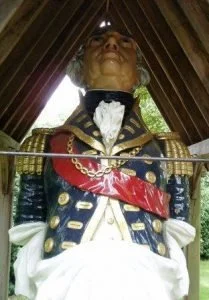Liberty of London’s Chiltern Connections
The luxury department store Liberty of London is known around the world for its close connection to art and culture but did you know that it has its roots in the Chilterns?
Most famous for its bold and floral print fabrics, the vast mock-Tudor store also sells men's, women's and children's fashion, beauty and homewares from a mix of high-end and emerging brands and labels.
Who Originally Owned Liberty?
By Arthur Hacker (1858-1919) - http://www.archibaldknoxsociety.com/knox/liberty.html, Public Domain, https://commons.wikimedia.org/w/index.php?curid=4226757
The man who set up Liberty in 1872, Arthur Lasenby Liberty, was born on 13 August 1843 in Chesham, Buckinghamshire, England. He was the son of a draper. When he was sixteen he was apprenticed to a draper in London, but didn’t enjoy it and moved on to the famous and highly successful “Farmer and Rogers’ Great Shawl and Cloak Emporium” in Regent Street during the 1860s. By 1874, rejected for a partnership, and encouraged by over 10 years experience, he decided to start a business of his own. With a £2,000 loan from his future father-in-law, in 1875, he accepted the lease of half a shop at 218a Regent Street with three staff members.
Growing the Business
By Unknown author - https://books.google.com/books?id=wqUDAAAAYAAJ&printsec=titlepage#PPP7,M1, Public Domain, https://commons.wikimedia.org/w/index.php?curid=5398797
Liberty gradually expanded his business and by the 1880s his shop had seven departments: Silks, Embroideries, Furniture, Carpets, Porcelain, Curios and Miscellaneous Items. There was a great demand for the goods that Liberty was selling.
In 1885, 142–144 Regent Street was acquired and housed the ever-increasing demand for carpets and furniture. The basement was named the Eastern Bazaar, and it was the vending place for what was described as "decorative furnishing objects". He named the property Chesham House, after the place in which he grew up. The store became the most fashionable place to shop in London, and Liberty fabrics were used for both clothing and furnishings.
In 1889, playwright Oscar Wilde, a regular client of the store, wrote "Liberty's is the chosen resort of the artistic shopper".
Moving Back Home to Buckinghamshire
Arthur Lasenby Liberty never lost his affection for the county of his birth and in 1894 Arthur and his wife, Emma, moved to Buckinghamshire to rent the Manor House at The Lee and became very involved in the local community.
In 1898, Arthur bought the manor from John Plaistowe. As Lord of the Manor, he extended the estate to cover over three thousand acres, stretching well beyond the parish boundaries. The estate eventually comprised twelve working farms, many houses and cottages and ‘lots of pubs’.
He did much to improve the village, including new cottages, fresh water to The Lee pumped from Missenden valley (but not to other communities which were then outside of The Lee parish), a village green, cricket pitch, football ground and, in 1911, improvements to the Parish Church. The designs for the fitments and decorative works in the church were prepared by Mr F Terrell Brown under the joint supervision of Mr John Llewellyn and Arthur Liberty, and each piece was carved, cast and crafted in the Liberty workshops. Much of what can seen in the church today is almost exactly as it was when work was completed in May 1911.
Photo from 1911 showing the completed work on the altar of St John the Baptist. Thanks to www.thelee.org.uk
A New House Near The Lee
Arthur Lasenby Liberty also built a house near The Lee – ‘Pipers’ – for his nephew and eventual heir, Ivor Stewart-Liberty. At the entrance to this house is a wooden figurehead of Admiral Lord Howe taken from the Navy’s last wooden warship, HMS Impregnable (previously called HMS Howe).
Photo thanks to https://www.thelee.org.uk/
In 1921 HMS Impregnable and HMS Hindustan were broken up and their timbers were used to build the mock Tudor extension to the Liberty store in London in 1924. The figurehead of Admiral Lord Howe was brought by Ivor to The Lee, where it has remained ever since.
The Legacy of Liberty
Arthur Lasenby Liberty died in 1917, seven years before the completion of his shops, so he never got to see the famous frontage of the Liberty store on Great Marlborough Street.
His encouragement of designers such as Archibald Knox helped develop Art Nouveau and the shop has had many collaborative projects – from William Morris and Dante Gabriel Rossetti in the nineteenth century to Yves Saint Laurent and Dame Vivienne Westwood in the twentieth century.
Recent collaborations include brands such as Scott Henshall, Nike, Dr. Martens, Hello Kitty, Barbour, House of Hackney, Vans, Onia, Manolo Blahnik, Uniqlo, J.Crew, Superga, Target, Adidas and T. M. Lewin.
Thanks to The Lee Parish Council. Find out more about The Liberty Influence and The Lee at https://www.thelee.org.uk/the-liberty-influence/
More photographs of the 1911 improvements to the church supervised by Liberty can be seen at https://www.thelee.org.uk/the-interior/





